

Updated January 2, 2025
Emoji and emoticon use can be an important part of business communication as people spend more time online during remote work. In 2020, Clutch surveyed 500 employees in the U.S. about their emoji habits and found that almost half of people use emojis at least once a day to help communicate feelings and expressions at work. Still, emoji use has only increased by 15% during COVID-19, as generations are split on whether emojis are professional.
Updated May 20, 2022
It’s been a record month at Dan’s company. Sales have increased and churn rate is low.
Looking for a BPO agency?
Compare our list of top BPO companies near you
Dan, 26, pulls together the monthly report, feeling good, and sends it to the company bookkeeper.
He titles the email "this month was [fire emoji].”
Ruth, the 68-year-old bookkeeper, responds, “I haven't had a chance to look yet, but it sounds like you had a rough month.”
Dan is confused and then he realizes: My emoji was misinterpreted.
John Ross, president of Test Prep Insight, an online education company, relays how this situation played out at his company. One of his younger employees sent a simple fire emoji in the subject line of a monthly report and his bookkeeper misinterpreted it to mean "the financials were so bad you wanted to burn them."
“It could have been the biggest misunderstanding of one of the most common emojis I have ever seen,” Ross said. “That said, we quickly cleared it up and laughed it off.”
Ross’s situation is one many businesses have experienced. Generational gaps at companies determine how people interpret emojis. However, many employees find emojis improve workplace communication and convey nuance in their messages.
In 2020, Clutch surveyed 500 people about how they use emojis at work and the main benefits of using emojis in the workplace. We found that businesses remain torn on the appropriateness of emojis in a work environment, with many employees preferring not to use emojis at work at all.
We discovered almost half of people use emojis every day, indicating a growing reliance on emojis to convey facial expressions and emotions. As many companies transitioned to remote work during the COVID-19 pandemic, emojis can be a helpful tool to keep employees connected in lieu of office interactions.
Still, people look to avoid translation mistakes when sending emojis because emojis are more open to interpretation than simple text-based emails and messages.
Looking for more insights on business emoji communication? Check out our 2021 report on translation mistakes.
Workers show different preferences for when they include emojis at work based on the communication tool they are using.
Our 2020 data found that people prefer using emojis at work in internal emails and meeting tool chats rather than in Slack or client-facing emails.
One-fifth of people (19%) used emojis in internal emails and 19% of people used emojis in meeting tool chats.
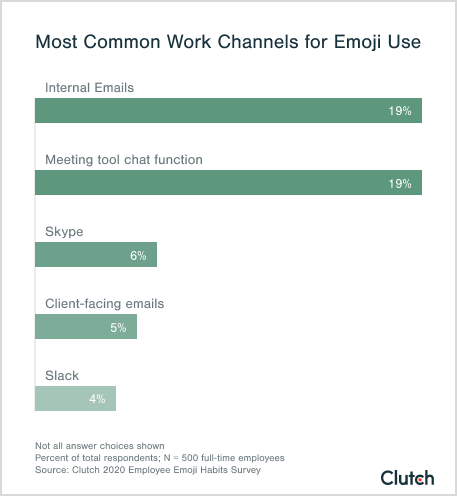
Only 4% of people used emojis in Slack in a span of 3 months when the survey was conducted, preferring to keep conversations more word-based. Meanwhile, 10% of companies didn’t even allow emojis at work when this data was conducted.
Employees seem most comfortable with using emojis internally in meetings or emails when they can provide more context for what their message means. While emojis can convey nuances in tone, experts recommend people always provide actual words around their emoji to prevent misinterpretation at work.
Since emojis can depend on how people translate their meaning, professionals should be wary of overusing emojis when the message they are sending is important.
At work, it is important to know the level and formality of your relationship with colleagues before using emojis. If you are sending a bunch of emojis to the CEO, with whom you have never interacted before, it could come off as unprofessional. Further, if you are messaging about a controversial or serious topic, you may not want to use emojis to avoid misinterpretation of your emoji’s meaning.
Just like in in-person conversations, it can be helpful to mirror your conversation partner's speech style. If the person you are messaging constantly uses emojis and understands a wide range of emoticons, then you can also include a variety of emojis in your conversation. However, if your conversation partner generally uses formal language and gets directly to the point, it may be better to not use emojis in your messaging.
At work, it can be difficult to determine how familiar people are with the entire emoji library. In 2020, there are 3,136 emojis that people can choose from to chat– over 100 new variations were released in 2022. Still, the most popular emojis at work tend to be more conservative and obvious in meaning like the generic smiley face, thumbs up, or clapping hands emoji. Sticking with these well-known emoticons is a better way to ensure your message is understood than including ones that could be misinterpreted.
It is always better to include text around your emoji rather than simply sending a bunch of emoticons all at once with no words. By creating context, you can use emojis to better convey the emotion or tone of the message without relying on the emoji to explain what you are thinking.
Deepak Shukla, founder of Pearl Lemon, an award-winning London-based SEO agency, explains how including context around the emoji is essential to avoid interpretation mistakes.
“Sometimes something encouraging can come off as curt if received without context,” Shukla said. “For example, a thumbs up without an accompanying message when receiving feedback might just look like you’re too annoyed to reply!”
A thumbs up without an accompanying message when receiving feedback might just look like you’re too annoyed to reply!
Ensuring that an emoji reinforces your message rather than providing a new meaning altogether can help your business communicate efficiently.
People remain torn on whether using emojis at work is appropriate due to how emojis could be interpreted incorrectly. As such, people vary in how frequently they use emojis and some may prefer not to use them at all.
In 2020, almost half of people use emojis at least once a day (44%) with one-third (32%) of people using an emoji multiple times a day in a span of three months.
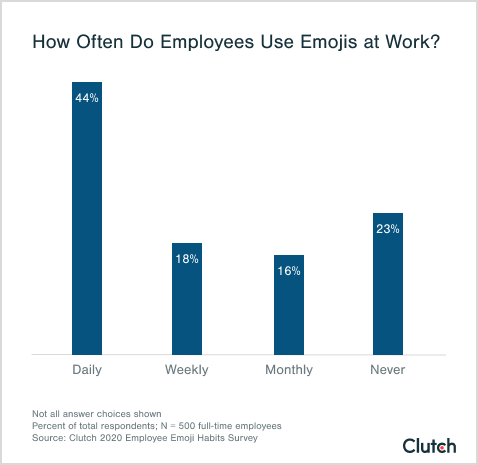
Still, almost a quarter of people (23%) never used emojis to communicate in that span of three months at work. Overall, 77% of people used emojis at work in that 3 month span.

The firm divide between who people use emojis constantly and people who don’t use emojis at all indicates a concern over what emojis connotate.
In the past, emojis have led to confusion over the author's intended meaning versus the emoji's perception. Some of these misinterpretations have even led to lawsuits.
For example, in Israel, a landlord won a lawsuit against two potential tenants who expressed interest in a piece of property using emojis. The potential tenants sent celebratory emojis to indicate they wanted to talk about the indicated property.
The landlord interpreted the emojis as a firm offer and took the property off the market. The potential tenants then disappeared. The landlord sued the tenants over the losses he had by taking the property off the market and he won his lawsuit.
While the tenants sent the celebratory emojis to indicate they had received the message, the landlord took it as confirmation of his property offer.
Appropriate emojis at work can also be a concern for management. Sending a “kissy face” emoji or “lips” emojis could quantify as sexual harassment depending on interpretation. Some companies may ban emojis just to avoid scenarios where the emoticons could put the company at risk for a lawsuit.
Still, there are a number of benefits to using emojis in workplace communication. Emojis foster camaraderie between coworkers and create stronger work relationships when used correctly.
Clients also respond to emojis in marketing emails similarly to how they respond to a human face. Adding a smiley face at the end of an Instagram post can increase engagement by up to 50%, which is a huge incentive for big brands to use them in Instagram ads.
Emojis in social media ads attract attention, make the message seem more organic, and can work around cultural barriers. For example, Starbucks frequently uses emojis in their Instagram ads:

Used all around the world, emojis are an easy way to communicate a message to people who speak different languages while also appearing casual and natural.
Still, audiences obviously react to emojis in different ways. Depending on the brand, it may not be useful to include emojis in ads or emails. For example, if a medical company started sending “money” and “syringe” emojis, people may get offended.
People should be aware of who their audience is and how often they send and see emojis. It is much easier to send a wide variety of emojis if you know that your recipient receives them frequently.
At work, emojis can sometimes be misinterpreted by the recipient with interesting results. Below are some real-life examples of how emojis at work have been misinterpreted:
McLean Mills, Co-Founder of Resume Writing Services, discusses how his emojis were misinterpreted in light of the pandemic:
“I actually recently sent out a text to a coworker with emojis to voice how chaotic things have been at work with the pandemic forcing everyone to work from home. However, my coworker actually misunderstood my text. He thought that it had meant I had tested positive for COVID-19 and texted back how worried he was for my well-being. Needless to say, it was a bit awkward for me to reply back and explain what I had really meant and that I was doing just fine.”
Sandra, Marketing and PR Manager at Nibble Video, a video animation company, describes her confusion with the connotation behind an animal icon:
“I once received an emoji I had no idea about the meaning of. It was a goat emoji. At first, I felt a bit insulted as I wasn't too sure what the sender had in mind, but it turned out that the goat emoji stands for "Greatest of All Time", and apparently it was a sign of appreciation of my work.”
Jessica Ulloa, from MyPerfectResume.com, describes how someone’s lack of knowledge about what certain emojis mean can result in a confusing tone in some work communication:
“I was working on a team of young professionals, and we used emojis in our internal communication all the time. Our manager was not too familiar with social media and emojis, but he wanted to be part of this “trend.” For a while, he would add the crying, laughing emoji when sharing bad news with us. For example: “We didn’t meet our target this quarter [laughing emoji].”
Akshaya Chandramouli, content marketing executive at Paperflite, discusses how one common emoji can have different meanings based on the context of the message:
“One emoji that is highly misunderstood and misinterpreted (at least in my case) is the humble smile emoji. Are you genuinely smiling? Have you killed me inside your head? Are you wearing it as a facade? Guess we’ll never really know.”
Eliza May Austin, CEO of th4ts3cur1ty.company, describes how her interpretation of an emoji unfolded into a strange situation:
“I actually sent what I thought at a glance was a smiling emoji to a business associate, who's wife found me on Linkedin to inform me it was, in fact, a hugging emoji, which apparently constitutes flirting."
American workers remain divided over the effectiveness of using emojis at work. Younger generations find emojis helpful to connect with other colleagues while older generations find them less useful.
In 2020, almost one-fifth of employees (17%) thought the main advantage of using emojis is to convey a message tone without using actual words and 14% of people believed they help express an emotion virtually.
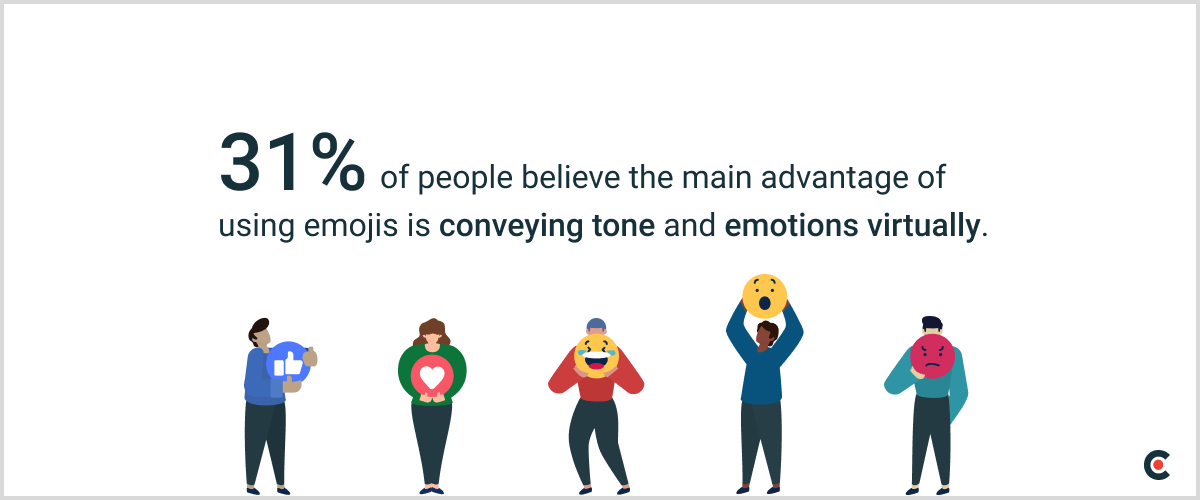
Further, 11% of people believed that emojis cultivate a less formal work culture.
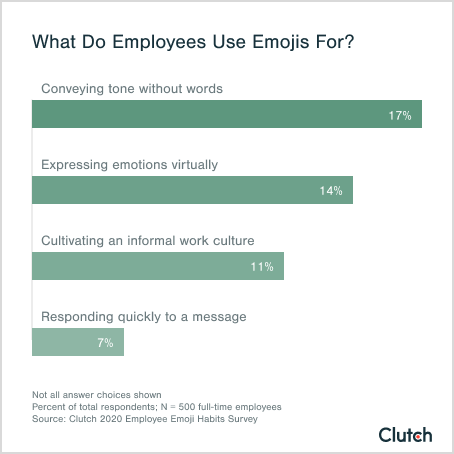
Only 7% found emojis useful to respond to messages quickly.
While people seem torn about the benefits of emoji use at work, the advantages become more clear when looking through the perspective of different age groups.
Over half of young professionals (18 to 29 years old) say that they use emojis to be funny and express their feelings. They prefer to use emojis to lighten the conversation and better connect with other people at work.
While young people believe that emojis can enhance communication at work, older generations take on a more negative view of emoticons.
Professionals over the age of 45 say emojis can harm workplace professionalism. Almost a quarter of employees over 45 (22%) say when colleagues use emojis they come across as “annoying, less genuine, or less competent,” according to Curiosity at Work.
Almost a quarter of employees over 45 (22%) say when colleagues use emojis they come across as “annoying, less genuine, or less competent.”
Only 15% of employees over the age of 45 say emojis improve workplace communication.
Emojis, however, can be vital to creating a comfortable work culture where employees feel free to express their emotions online with an icon.
Grant Aldrich, founder and CEO of OnlineDegree.com, an educational platform with tuition-free courses, explains how he thinks emojis can clarify message meaning and help remote teammates connect.
“I suggest that remote workplaces incorporate emojis into everyday communication,” said Aldrich. “Using emojis allows people to bring their 'real selves' to the remote workplace. People will engage with each other more when they can sense their personality, making the team more collaborative.”
Using emojis allows people to bring their 'real selves' to the remote workplace. People will engage with each other more when they can sense their personality, making the team more collaborative.
In place of the face-to-face communication that remote employees lack, people can convey their facial expressions with different emojis, such as smiley faces, angry faces, or laughing faces. It makes it easier for workers to establish a close connection with people who are not meeting in person.
While workers over the age of 45 may see emojis as hampering professionalism, emojis can benefit the company by clarifying meaning and creating better relationships between employees.
People prefer to use emojis casually with their coworkers over sending them to clients or upper-level management.
In 2020, one-third of people (31%) communicated with non-manager coworkers using emojis, indicating emojis are used in less formal relationships at work.
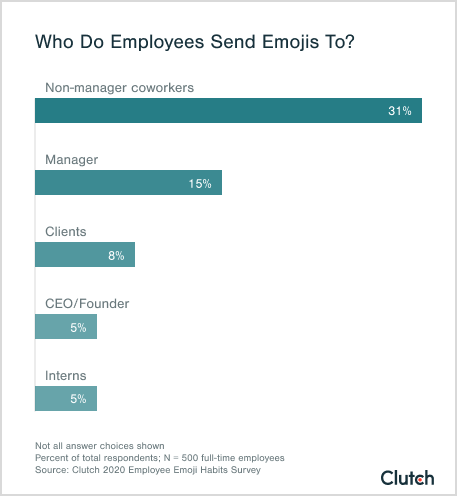
Meanwhile, only 5% of people felt comfortable sending emojis to the CEO or founder of their company. Further, only 8% of employees communicated with clients using emojis.
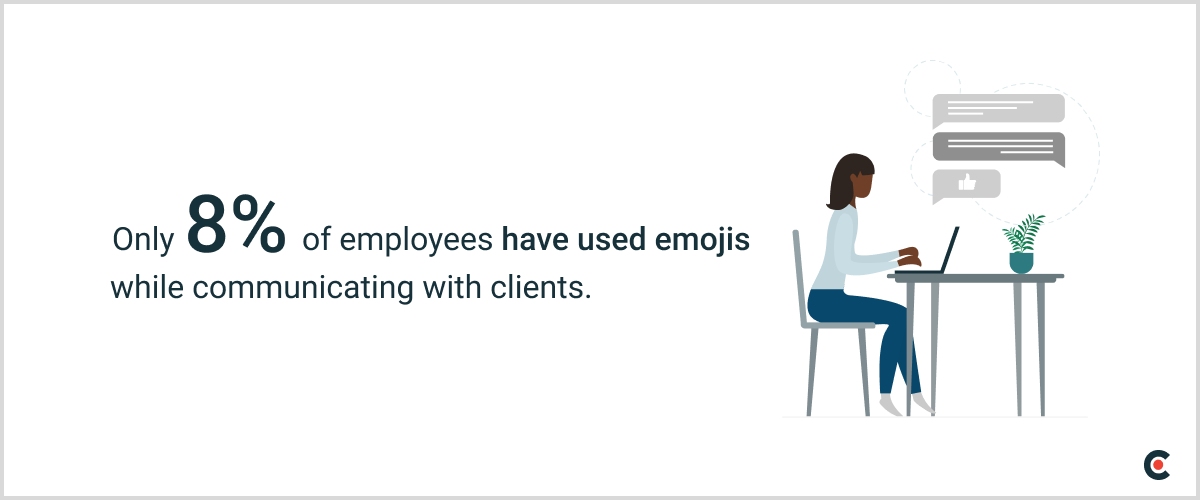
Understanding the best audience for your emojis can be essential to relaying professionalism in the workplace.
Workers feel comfortable sending emojis to someone they work with every day on their level but feel very differently about sending a bunch of emojis to the founder of the company. Sending emojis assumes a level of familiarity that the other party may not agree with.
People also avoid sending emojis to clients who may find the emoticons assuming and unprofessional. Clients want a level of respect from the vendor they hire, and that respect can be difficult to convey with emoticons.
The use of emojis at work is still controversial, especially depending on the business industry.
For example, Felicity Barber describes her experience in corporate finance where formality in emails was crucial to succeeding at work.
“In one of my last jobs in corporate finance, I sat right next to my boss’ boss’ boss,” Barber said. “Every now and then I’d hear him cry out in frustration. The problem? Someone had sent him an email with a smiley face in it—the precursor to today’s Emoji.”
Every now and then I’d hear him cry out in frustration. The problem? Someone had sent him an email with a smiley face in it—the precursor to today’s Emoji.
People respond to emojis differently based on their environment. While a small digital marketing firm may have no problem with emojis at work, a large finance firm may frown at it.
The coronavirus pandemic forced many businesses to close their physical offices and move work online. The rise of remote work has increased the amount of time people spend communicating through emails, video conferencing, and messaging tools.
Most people, however, seem to maintain their same emoji usage during COVID-19 as they did before the pandemic.
Only 15% of people said emojis use increased during COVID-19, though remote work continues to be the trend for many businesses.
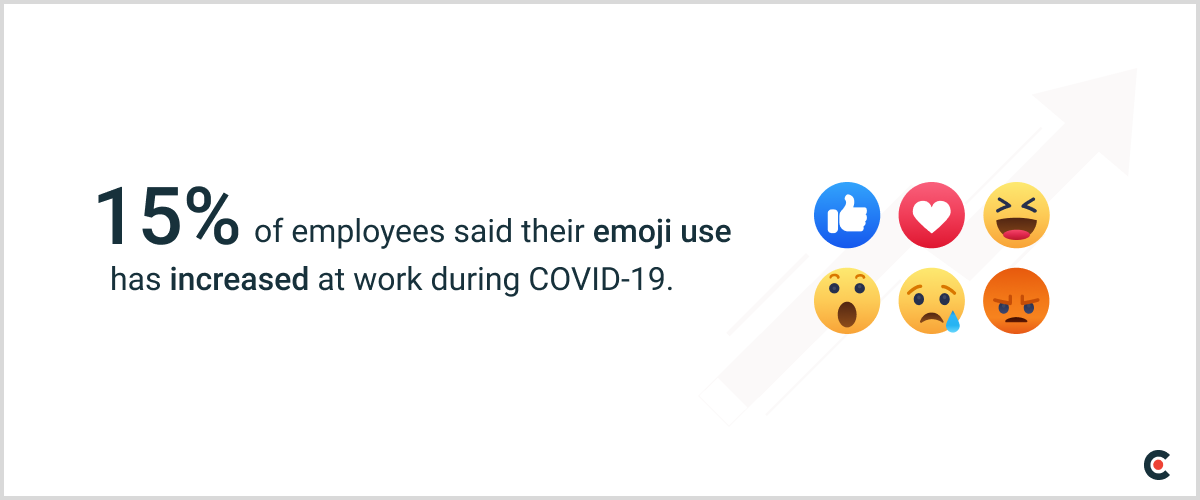
As some businesses transition to an online workplace, emojis can be a useful tool to maintain company morale and remain socially connected with colleagues.
Alexis Wirth is operations manager at Swenson He, a digital product agency based in Los Angeles and Dallas. He said emojis have helped boost company morale and improve relationships during COVID-19.
“Our goal with the use of emojis is not only for efficient communication but also to establish a work culture that understands that internal communication can be fun too,” Wirth said. “With everyone working from home, there are no longer "water cooler" conversation opportunities and we hope our staff can find ways to replicate the social aspect of work while they chat with each other.”
Our goal with the use of emojis is not only for efficient communication but also to establish a work culture that understands that internal communication can be fun too
Not only have emojis helped staff stay connected during COVID-19, but they have also helped lighten client communication during the pandemic.
Chris Kaiser, founder and CEO of Click A Tree, a company dedicated to planting trees to fight climate change, says that emojis have helped increase positivity among his clients.
“In a year that was dominated by crisis and negative news, we decided that emojis can put a smile on people's faces,” Kaiser said. “It even helped improve our response rate in cold outreach emails. It seems people like it - and it sets us apart from all the sterile business communication.”
While only 15% of people have increased their emoji usage in COVID-19, businesses may want to consider using more emojis in internal company communication to keep employees invested in work culture.
Employees remain torn on whether emojis benefit the workplace or hurt professionalism as emojis are often misinterpreted, according to data in 2020.
One-fifth of people prefer to use emojis in internal emails and another 19% like to use emojis in meeting tools chats. People remain more hesitant to send emojis over client-facing emails.
Almost half of people (44%) use emojis at least once a day while a quarter (23%) have not used emojis at all in the past 3 months.
Meanwhile, 31% of employees think that emojis help to convey tone and visualize emotions better in workplace communication. Using emojis can create a better work culture that creates stronger connections between coworkers, especially in a remote environment.
As well, 31% of people felt comfortable sending emojis to non-manager co-workers while only 5% sent emojis to the CEO or founder of the company. People find emojis make communication more conversational and informal, which can be useful between same-level colleagues but feels inappropriate with higher-level management.
Finally, only 15% of people increased their emoji usage during COVID-19 although many businesses transitioned to remote work. People like using emojis in remote work because it acts as a replacement for conveying facial expressions.
While emojis are not universally accepted as professional across businesses, companies can consider integrating them more consistently into internal communication to help cultivate work culture across all channels.
Browse Clutch's translation services directory to find a provider that won't leave you lost.
Clutch surveyed 500 people across the U.S. about their emoji habits at work. The survey ran from October 29 - November 2, 2020.
About 48% of the respondents were male; 42% were female; and 10% declined to indicate their gender.
31% of respondents are aged 55 or older; 40% are between the ages of 35 and 54; 14% are aged 25 to 34, and 4% are aged 18 to 24.


